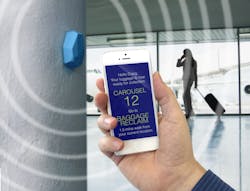The Wonders of Wayfinding
The potential of wayfinding and location-based technology at airports has been on the air transport industry’s agenda for a few years now. SITA’s 2015 Airport IT Trends Survey revealed that the vast majority of airports are exploring different ways of exploiting wayfinding in their terminals, with 91percent planning on adding it to their mobile apps by 2018 for instance.
A number of tools and approaches have featured on the location-based services landscape, including Wi-Fi triangulation, Indoor GPS and Bluetooth. Each has its own strengths but it was with the arrival of beacons that the location services scene came to life. Simple and cheap to install and operate, beacons were a no brainer for those looking to harness the potential of proximity sensing.
Very simply, beacons are indoor proximity devices which come in various shapes and sizes. They can be as small as a USB stick or larger and more visible. They transmit a signal using Bluetooth low energy - BLE for short - and the signal contains a unique identifier for that beacon.
When a BLE-enabled device, such as a smartphone, moves within range of the beacon’s signal it can trigger an action, such as displaying a contextually relevant message on the phone. Beacons have made a whole new range of user interactions possible.
The beacon can trigger an app on passengers’ smartphones to send notifications to direct them to areas of interest and provide additional information about their flights, such as boarding alerts and directions to the gate or baggage collection area. It can also send promotional coupons as they enter a specific zone, such as a shop, cafe or airport lounge.
Beacons can help reduce congestion and bottlenecks, improving the passenger flow in airports by giving passengers accurate and timely information. In turn, that leads to smoother boarding and more on-time departures. Providing wayfinding information also means that passengers know how long it will take to get to the gate, increasing the time they spend in the retail area, which is good news for the airport’s tenants.
Making beacons accessible for all
When airlines, airports and other airport vendors started exploring beacon technology, it became very clear that the industry would need a consistent deployment for beacons in airports across the world.
That’s why SITA set up the Common-Use Beacon Registry for the air transport industry. Working with leading airports, airlines and industry bodies like IATA and ACI, SITA is helping to define standards around how to deploy and use beacons for maximum interoperability.
For those using the registry, it means beacons can be operated using the common-use approach that’s proved so successful with other shared services and infrastructure at airports across the world. The Registry provides app developers with information about beacons deployed at airports, and contextual information for airline/airport apps to create amazing passenger experiences.
For example, the registry can tell app developers if a beacon is at a lounge, check-in, security area, baggage carousel or gate and specifically which gate. Combining this indoor-location information with passenger itinerary data creates a wide range of use cases that can be implemented by app developers.
The registry has solved the problem of multiple airlines wanting to install separate beacons at an airport’s shared gates or indeed throughout the airport. It is also open to commercial tenants such as retailers, facilities management and catering establishment that also want to use beacons. It has simplified the process of connecting multiple airports’ beacons together in a cohesive way for all interested parties. The registry is beacon-vendor agnostic and ensures beacons use a common form of data sets based on industry standards. This enables all industry players to leverage existing common-use beacon deployments at airports throughout the world – including developers looking to create new apps for use worldwide.
Thanks to the efforts of a few pioneering airports and airlines, passengers and staff can already experience the benefits of wayfinding technology. So what do the real life examples look like?
Miami International Airport
Miami International Airport (MIA) is one of the best examples of an airport using technology to improve the airline and passenger experience. One of its great initiatives has been its location-aware airport app. Traditional airport apps don’t know when you’re flying or where you are, how you’re getting to the airport, or what you want to do once you arrive. They’re passive. Not so with Miami’s app.
MIA become the first airport in the U.S. to use location-aware technologies in a mobile app – including Bluetooth beacons – to get the right information to the right people, when and where they need it.
The new mobile app, designed for passengers and all airport users, gives travelers personalized updates, directions and tips based on their location and needs – all through a highly intuitive interface.
Described by the airport as ‘Your Personal Travel Assistant’, the MIA Airport Official app can be used on iOS and Android devices from anywhere in the world. Once opened, it offers options based on location, so a user in Miami will get a different experience than someone opening it in London, Bogotá or New York.
As travelers make their way through the airport, the app provides information and support relevant to their individual journey. It includes updates on gate, flight times and baggage collection, as well as nearby food and retail outlets, prioritizing suggestions based on current location.
The app presents the most accurate and up-to-date indoor maps. And with ‘blue-dot’ functionality, map rotation, turn-by-turn directions, ‘walk times’ and a ‘near me’ feature, they allow passengers to quickly locate virtually anything inside the airport.
SITA took the initiative to develop an app that offers a personal experience and incorporates the latest technologies, including Miami’s beacon infrastructure and a selection of SITA industry APIs, enabling a context and location-aware experience.
What this means is that anyone who uses Miami International Airport will find this app incredibly useful. SITA was able to draw on decades of experience with airlines and airports and worked very closely with the team in Miami to deliver the world’s most technologically advanced airport app.
Nice Airport
In October last year, Nice Côte d’Azur Airport opened the first part of the refurbished Terminal 1 retail area with a wider range of outlets and more circulation areas, making the area more enticing and welcoming for departing passengers.
The airport took this opportunity to create a new multifunctional app which leverages beacon technology to put personalized information at passengers’ fingertips. The app will also support the refurbishing of the commercial area of Terminal 2 in 2016.
Nice Côte d’Azur Airport is leading the way alongside Miami by using beacons and SITA’s Common Use Beacon Registry to provide passengers at the airport with real-time, relevant information each step of the way. As well as wayfinding, retail information and offers relevant to location for all airport users, Airport Premier Club passengers using the app will automatically earn points as they pass through the airport.
Nice Côte d’Azur Airport has acknowledged the increasing amount of control passengers crave over their airport experience. Passengers want more personalized services from airports to match their individual requirements and the new airport app offers a highly tailored experience to passengers. For example, the new technology will facilitate access to Fast Track Security for Airport Premier Gold members, allowing them to use their frequent flyer card automatically.
American Airlines
American Airlines was the first to use SITA’s Common Use Beacon Registry in a pilot program at Dallas/Fort Worth International Airport, with what was at the time the world’s largest deployment of beacons by an airline. It aimed to provide passengers with up-to-date and relevant information on their mobile devices.
American Airlines is working to build beacon support into its mobile app to give a more personalized response to its Admiral Club members entering its lounges to help them avoid queues at busy times. The app will offer what the airline’s Director of CRM and Sales Support IT, Jason Newton, calls “seamless access” to the club, which he describes as an “industry first”. As part of the service, as members enter, their photos and flights details will appear on attendants’ screens.
Numerous other airlines are pioneering in the field beacons, and working with SITA, including Singapore Airlines, United Airlines, and more. In conjunction with Singapore Airlines and mobile app vendor MTT, the SITA Lab deployed 30 beacons around the airline’s lounge in Terminal 3 of Changi Airport. A mobile app was designed to show the location of passengers within the lounge enabling staff to quickly locate them should they be late for a flight.
Meanwhile, United Airlines’ customers flying through its New York Newark Liberty International hub can pinpoint their location within the Terminal C complex via the airline's app for iOS devices. Way-finding is high on the agenda, such as directions to various locations including the gate, nearby airport vendors and services such as restaurants, ATM locations or family restrooms.
Travelers are accustomed to using maps and navigation apps throughout their daily lives – airlines and airports both think that shouldn't end when they walk into
About the Author

